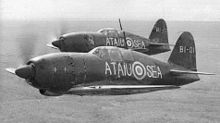
The Curtiss P-40 Warhawk is an American single-engined, single-seat, all-metal fighter and ground-attack aircraft that first flew in 1938. The P-40 design was a modification of the previous Curtiss P-36 Hawk which reduced development time and enabled a rapid entry into production and operational service. The Warhawk was used by most Allied powers during World War II, and remained in frontline service until the end of the war. It was the third most-produced American fighter of World War II, after the P-51 and P-47; by November 1944, when production of the P-40 ceased, 13,738 had been built, all at Curtiss-Wright Corporation's main production facilities in Buffalo, New York.
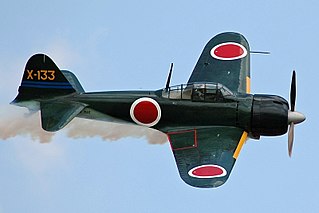
The Mitsubishi A6M "Zero" is a long-range carrier-based fighter aircraft formerly manufactured by Mitsubishi Aircraft Company, a part of Mitsubishi Heavy Industries, and was operated by the Imperial Japanese Navy (IJN) from 1940 to 1945. The A6M was designated as the Mitsubishi Navy Type 0 carrier fighter, or the Mitsubishi A6M Rei-sen. The A6M was usually referred to by its pilots as the Reisen, "0" being the last digit of the imperial year 2600 (1940) when it entered service with the Imperial Navy. The official Allied reporting name was "Zeke", although the name "Zero" was used colloquially as well.

The Thach weave is an aerial combat tactic that was developed by naval aviator John S. Thach and named by James H. Flatley of the United States Navy soon after the United States' entry into World War II.

The Mitsubishi A5M, formal Japanese Navy designation Mitsubishi Navy Type 96 Carrier-based Fighter (九六式艦上戦闘機), experimental Navy designation Mitsubishi Navy Experimental 9-Shi Carrier Fighter, company designation Mitsubishi Ka-14, was a WWII-era Japanese carrier-based fighter aircraft. The Type number is from the last two digits of the Japanese imperial year 2596 (1936) when it entered service with the Imperial Navy.

The Nakajima Ki-43 Hayabusa, formal Japanese designation Army Type 1 Fighter is a single-engine land-based tactical fighter used by the Imperial Japanese Army Air Service in World War II.
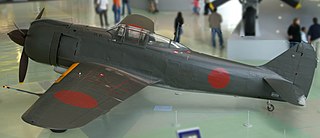
The Kawasaki Ki-100 (キ100) is a single-seat single-engine monoplane fighter aircraft used by the Imperial Japanese Army Air Service during World War II. The Japanese Army designation was "Type 5 Fighter". It was not assigned an Allied code name.

The Mitsubishi Ki-46 was a twin-engine reconnaissance aircraft used by the Imperial Japanese Army in World War II. Its Army Shiki designation was Type 100 Command Reconnaissance Aircraft (一〇〇式司令部偵察機); the Allied brevity code name was "Dinah".

The Nakajima Ki-84 Hayate is a single-seat fighter flown by the Imperial Japanese Army Air Service in the last two years of World War II. The Allied reporting name was "Frank"; the Japanese Army designation was Army Type 4 Fighter. The Ki-84 is generally considered the best Japanese fighter to operate in large numbers during the conflict. The aircraft boasted high speed and excellent maneuverability with an armament that gave it formidable firepower. The Ki-84's performance matched that of any single-engine Allied fighter it faced, and its operational ceiling enabled it to intercept high-flying B-29 Superfortress bombers. Pilots and crews in the field learned to take care with the plane's high-maintenance Nakajima Homare engine and a landing gear prone to buckling. The difficulties of Japan's situation late in the war took a toll on the aircraft's field performance as manufacturing defects multiplied, good quality fuel proved difficult to procure, and experienced pilots grew scarce. Nevertheless, a well-maintained Ki-84 was Japan's fastest fighter. A total of 3,514 aircraft were built.

The Nakajima Sakae was a two-row, 14-cylinder air-cooled radial engine used in a number of combat aircraft of the Imperial Japanese Navy and Imperial Japanese Army before and during World War II.

The Nakajima J1N1 Gekkō is a twin-engine aircraft used by the Japanese Imperial Navy during World War II and was used for reconnaissance, night fighter, and kamikaze missions. The first flight took place in May 1941. It was given the Allied reporting name "Irving", since the earlier reconnaissance version the J1N1-C, was mistaken for a fighter.
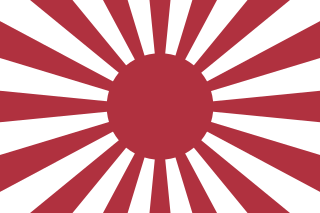
The Imperial Japanese Army Air Service (IJAAS) or Imperial Japanese Army Air Force was the aviation force of the Imperial Japanese Army (IJA). Just as the IJA in general was modeled mainly on the German Army, the IJAAS initially developed along similar lines to the Imperial German Army Aviation; its primary mission was to provide tactical close air support for ground forces, as well as a limited air interdiction capability. The IJAAS also provided aerial reconnaissance to other branches of the IJA. While the IJAAS engaged in strategic bombing of cities such as Shanghai, Nanking, Canton, Chongqing, Rangoon, and Mandalay, this was not the primary mission of the IJAAS, and it lacked a heavy bomber force.

Japan Airways Co.Ltd was the national airline of the Empire of Japan during World War II.

The Manchuria Airplane Manufacturing Company was an aircraft company in Manchukuo in the 1930s and 1940s, producing a variety of mostly military aircraft and aircraft components. It was named Manshū or Mansyuu in short.
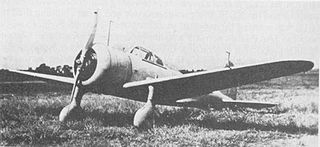
The Nakajima Ki-27 was the main fighter aircraft used by the Imperial Japanese Army Air Service up until 1940. Its Allied nickname was "Nate", although it was called "Abdul" in the "China Burma India" (CBI) theater by many post war sources; Allied Intelligence had reserved that name for the nonexistent Mitsubishi Navy Type 97 fighter, expected to be the successor to the carrier-borne Type 96 with retractable landing gear and an enclosed cockpit.

Neel Ernest Kearby was a United States Army Air Forces colonel and P-47 Thunderbolt pilot in World War II who received the Medal of Honor for his actions in combat. Kearby is the first United States Army Air Forces fighter pilot to have received the Medal of Honor. He scored 22 aerial victories and was the top-scoring P-47 pilot in the Pacific Theater.

The Kawasaki Ki-48, was a Japanese twin-engine light bomber that was used during World War II. Its Allied reporting name was "Lily".

The Mitsubishi Ki-18 was an unsuccessful and unsolicited attempt by Mitsubishi to meet a 1934 requirement issued by the Japanese Army for a modern single-seat monoplane fighter suitable to the needs of the Imperial Japanese Army Air Force. During this competition, Nakajima entered the Nakajima Ki-11, and Kawasaki entered the more maneuverable Kawasaki Ki-10 biplane. The competition was won by Kawasaki, but the new fighter was not accepted by the IJAAF with much enthusiasm.

Eagle Farm Airport(IATA: BNE, ICAO: YBBN) was a small airport located 6 km (3.7 mi) north-east of Brisbane in the suburb of Eagle Farm, Queensland, Australia.

The World War II Allied names for Japanese aircraft were reporting names, often described as codenames, given by Allied personnel to Imperial Japanese aircraft during the Pacific campaign of World War II. The names were used by Allied personnel to identify aircraft operated by the Japanese for reporting and descriptive purposes. Generally, Western men's names were given to fighter aircraft, women's names to bombers, transports, and reconnaissance aircraft, bird names to gliders, and tree names to trainer aircraft.

Second World War Hangar No. 7 is a heritage-listed hangar at 116 Lamington Avenue, Eagle Farm, City of Brisbane, Queensland, Australia. It was designed by the United States Army and built from 1942 to c. 1952 by Manuel Richard Hornibrook. It was added to the Queensland Heritage Register on 7 February 2005.

